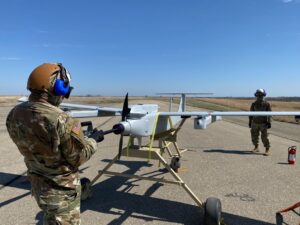The Army’s lead official for Future Vertical Lift (FVL) development said Wednesday there is high demand for the service’s new Future Tactical Unmanned Aircraft System (FTUAS), including out of Europe.
“I know the demand for FTUAS is high. We’ve had demand signal from Europe and all the things that are going on there. So, again, very proud that we started this program as early as we did, sensing the demand and then happy that we’re following through on that demand as an Army,” Maj. Gen. Walter Rugen, director of the FVL Cross Functional Team, said during a C4ISRNET discussion.

FTUAS is the Army’s program to field a new capability to replace its RQ-7B Shadow drone, with the service announcing last week it selected AeroVironment’s JUMP 20 system for the first increment of the program to meet an immediate operational need and inform requirements for the eventual enduring capability (Defense Daily, Aug. 19).
Under the $8 million FTUAS Inc. 1 deal, AeroVironment [AVAV] will deliver one JUMP 20 system consisting of six air vehicles, ground data terminals and ground control stations, with options for the Army to potentially procure seven additional systems.
“From a requirements standpoint, we very much like an increment strategy. I mean, that’s what Army aviation’s been very good at,” Rugen said. “This [FTUAS] Inc. 1, although it’s small, is a three-year acceleration on the program. And it’s coming out of, what I view as, probably the best soldier touchpoint we’ve had, where soldiers told me…they were re-enlisting because this capability was coming into their formations. So we owed it to the soldiers to get them the best and to move out fast with Inc. 1.”
The FTUAS Inc. 1 award followed a year-long evaluation process with several different offerings, including AeroVironment’s JUMP 20, Martin UAV’s V-Bat, Textron’s [TXT] AAI Corp.’s Aersonde and L3Harris’ [LHX] FVR-90.
In parallel to Inc. 1, the Army is currently assessing white paper submissions for FTUAS Inc. 2, which is a rapid prototyping effort to field an enduring capability for a program of record to replace its Shadow drones.
An initial award to selected prototype vendors for FTUAS Inc. 2 is slated for fiscal year 2023, an Army spokesperson previously told Defense Daily.
Brig. Gen. Rob Barrie, the Army’s Program Executive Officer for Aviation, has said the Army will utilize a full and open competition for both the FTUAS Inc. 2 prototyping phase and the eventual production award, while adding that the four participants in the prior evaluation period will have a “firmer understanding” of how the Army arrived at its final requirements (Defense Daily, Sept. 3 2021).
Rugen was asked if the Army is seeing a deeper pool of competitors for FTUAS Inc. 2 than when the Army first initiated the program in 2018.
“We’re seeing a lot of innovation in this space and that’s what we love to see. And the competition, obviously, brings us greater capability, typically at a lower cost,” Rugen said in response.
The Army has said FTUAS aims to replace Textron’s Shadow drone with a “vertical takeoff and landing, runway-independent, reduced acoustic signature aircraft that can be transported organically while providing commanders with ‘on the move’ reconnaissance, surveillance, and target acquisition capabilities.”
FTUAS is intended to meet requirements for rapid emplacement in less than 45 minutes, have a smaller footprint than Shadow, be transportable by a single CH-47 Chinook, provide over six hours of operating time and operate out to 100 kilometers
When asked if the Army may seek additional capabilities with FTUAS Inc. 2 that it did not include for Inc. 1, Rugen declined to offer specifics and noted such information would be communicated to industry through the requirements process.
“I think it’s all out there. I don’t want to necessarily voice over something that, you know, [industry] is working on now. Industry understands where and what we want and when we want it. And I’ll just leave it at that RFP (request for proposals) level,” Rugen said.